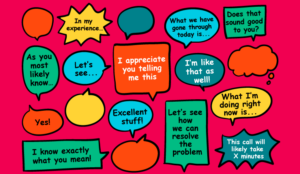We reveal seven useful tactics for better dealing with difficult customers in the contact centre.
But before we present these ideas, we will first share some expert advice for dealing with the “I’d Like to Speak to a Manager” conundrum.
Dealing With the “I’d Like to Speak to a Manager” Conundrum
One of the most tricky positions that difficult customers put advisors in is when they want to speak to a manager or supervisor.
Most of the time, the call will descend into this state, but in some cases, the customer will ask to be put straight through to the manager.
Both scenarios can be difficult to navigate, but in the video below, Lee Jones, Sales Director at Elev-8 Performance, shares some great advice for dealing with this difficult situation.
More great pieces of advice for dealing with the “I’d Like to Speak to a Manager” request include:
- Create a call-escalation policy – Advisors can panic when they don’t understand what you expect from them in terms of whether they should escalate the contact or not. So take Lee’s advice from the video above, turn it into a flow diagram and share it with advisors as a useful visual aid.
- Lay out the rest of the call – When a customer asks for an escalation, but you – as the advisor – are confident that you can solve the query, tell them that in a non-confrontational, humble way. Lay out what you are planning to do to help them, step by step, and ask the customer if they are happy for you to follow that process (nicely!).
- Analyse the cause of the request – When leaders have to deal with a call escalation, they should consider the coaching or process gap that led to the customer making the request – especially if it is a repeat cause. Knowing this and acting on it will prevent the issue from cropping up again.
Yet there is far more to dealing with difficult customers than handling call escalations, as we explore in our seven key strategies below.
For more on dealing with requests to speak to a manager, read our article: How to Handle Call Escalations
1. Understand the Four Types of Customer Preference
A difficult customer can be “difficult” in a number of different ways. They could be angry, indecisive or maybe just incredibly talkative. There are a lot of difficult customer types.
When an advisor picks up the phone, they don’t know which of these personality types they will have to talk to. They could have to deal with anything.
Yet all customers have preferences in how they communicate, and what advisors can do is essentially work out where the customer’s preference may sit and adapt their approach accordingly.
Lee shares and explains an interesting model for how to do this in the video below, as well as some other great ideas for dealing with difficult customers.

Lee Jones
As outlined in the video, Lee suggests that people fall into four categories:
- People who gravitate towards people and create harmony (i.e. people-people)
- People who are direct and efficient
- People who publicize their personality and like to be outgoing
- People who are more analytical and logical thinkers
The point here is that advisors should not be anxious that the customer is going to be “difficult”, they should be ready for the customer and how they like to be dealt with.
If we can spot the customer’s preferences through their language and the way that they’re acting and try to match their preference, we can communicate in a way that best suits them.
Of course this takes a lot of coaching, but it helps to take away the fear of dealing with the difficult customer, while improving customer service.
2. Step Back for a Moment…
When solving a customer’s problem starts to go wrong and the difficult customer is putting pressure on you, take a step back. Give yourself the space to recover and accept that things are getting tricky.
Then it’s time to be honest with the customer. As Lee says: “Customers love honesty. Yet too often we see honesty as a threat to our own capability.”
With this in mind, the advisor can help themselves out by saying something along the lines of:
“This isn’t going the way that I think you want it to go – but I believe that I can answer this for you. So let’s go back and take another look at the problem…”
Using a statement like this is a great way of getting a ten-second break, allowing you to look back on your notes and reflect.
We can use this time to try and remember what the customer was actually asking for – taking a step back from where we’ve ended up.
This technique can be really valuable for contact centres where advisors have to follow strict processes and scripts – because things can get really difficult for advisors when the answers aren’t in those processes.
So another answer here is to look at how we can harness the wisdom of the contact centre, giving advisors the real-time support they need to support the difficult customer. This could be done through a Slack channel that’s monitored constantly by experienced advisors, for example.
Find our advice for moving away from an adherence culture and harnessing the wisdom of the contact centre in our article: What Is the Best Model for Contact Centre Culture?
3. Stop Forcing Customers Down a Certain Route
Many organizations, especially when the contact centre gets busy, force customers down a route that they wouldn’t necessarily choose – using shifty IVR messaging and website design.
Sometimes these companies also tell a customer to use one channel, only for that channel to be closed. Other times contact centres try to hide their telephone number on their website.
If you use any of these strategies, you are frustrating customers who would otherwise be pleasant and turning them into difficult customers who take up even more of your time.
In the contact centre, your main focus should be on resolving issues and ensuring that customers feel safe in your hands. This is critical.
For this reason, Rob Clarke, Director of Growth at Elev-8 Performance, recommends Amazon’s approach to customer navigation.

Rob Clarke
“On Amazon’s website, they recommend a channel to contact them regarding a certain issue. However, they also display all of the other contact options available on the same page,” says Rob.
“This means that the customer isn’t being forced down a certain route, but there is an anchor there as to what works best for Amazon.”
The example that Rob gives is a nice reminder to ensure that when we are making decisions in the contact centre, we should do so in consideration of customer, employee and business needs. If we don’t do this, we will generate even more difficult customers for advisors to deal with.
4. Reframe the Conversation in a Positive Light
In 99 out of 100 cases the customer has not just phoned up for a chat. There is a reason why they are there.
So gaining permission to resolve the query, understanding what good looks like for the customer and owning that, is a great way to approach and frame a customer conversation.
While that advice may seem obvious, how many times do you encounter an advisor who says something like:
- “I can’t do that”
- “There is nothing that I can do”
- “All I can do is…”
When an advisor does say these things, the customer will naturally think that they are not talking to the right person, which can lead to them becoming more difficult and asking for a call escalation.
If an advisor does feel the need to say: “All I can do for you is…” it’s important that we coach them to reframe the conversation and say something like:
“What I can do for you is… and when I’ve done that I’m going to pass you over to one of our highly skilled engineers, who can do the next bit for you.”
In order for an advisor to do this, we must also allow them to deviate from call scripts, so advisors can modify their language to encourage a better flow of conversation with the difficult customer.
For more examples of unhelpful things that advisors say to customers and better alternatives, read our article: 15 Things a Call Centre Agent Should Never Say (But Many Do)
5. Take Yourself out of Autopilot Mode
As Lee says: “We don’t know what the customer’s problem is until we take ourselves out of autopilot mode, listen to them and ask questions.”
Of course listening and asking questions are the fundamentals of customer service, but Lee stresses the importance of taking yourself out of autopilot mode as well because it is something that advisors often struggle with, having to take call after call after call.
The danger of being in autopilot mode is that it causes us to rush to assumptions. We jump to conclusions because we think that we’ve heard the customer’s problem before.
The danger of being in autopilot mode is that it causes us to rush to assumptions.
Yet when we do that, we drive call escalations and customer dissatisfaction because we have to treat every problem like we’ve never heard it before – especially with difficult customers.
Why? Difficult customers – particularly if they are angry or talkative – like to be given the space to vent. You, as the advisor, are denying them that by rushing to a conclusion.
Also, by assuming we know the customer’s problem, we are likely to frustrate them even further if we misunderstand something, causing a long, uncomfortable conversation or, even worse, a second contact.
6. Use the Intensity-Reduction Method
If you match the customer’s pace, tone and volume in your conversation, and then carefully bring your volume down, so you’re talking at a more comfortable level, you can influence them to follow your lead.
You will find that the customer will gradually follow suit and talk at a more relaxed pace and tone.
By doing this subtly with loud and frustrated customers, you will find that the customer will gradually follow suit and talk at a more relaxed pace and tone.
Just be aware that this requires a lot of practice and that you can’t start a short sentence very loudly and then finish it off quietly; it’s more of a journey through the opening of the call.
There are a few similar techniques like this that work well in terms of influencing the behaviour of difficult customers, including:
- Demonstrate that you understand the customer’s problem – By taking a quick moment to check your understanding of the issue with the customer, you can ensure that they realize that you are fully aware of the problem.
- Reflect back certain words that the customer uses – Pick out certain words that the customer uses and reflect them back, so that they realize that you understand how they feel. For example, if the customer describes a problem as “difficult”, say “I can see why this must be difficult for you.”
- Take ownership of the customer’s problem – Take the weight off the customer’s shoulders by seizing control of the issue, so they can relax knowing that you are in control of their problem. For this, you can use statements like “We will help you get this issue resolved.”
As a note of caution with each of these techniques, make sure they have been well coached so that advisors feel comfortable in using them.
For more quick tips for dealing with difficult customers, read our article: 5 Quick Fixes for Dealing With Problem Callers
7. Embrace the ACT Model for Change
Contact centres often fall into the trap of doing training in a certain way because that’s what they did last time, or they follow a convenient, off-the-shelf module.
But change works so much better when you take people on a journey, which starts by making people aware of the need for it.
This “Awareness” is represented by the letter “A” in the ACT model for helping advisors to improve performance and better deal with difficult customers. The ACT model is highlighted below:
- Awareness – This stage involves finding out what needs to change and why
- Choice – This stage involves getting advisors to visualize the benefits for them in making the change
- Transform – This stage involves coaching and upskilling advisors and giving them a stress-free environment to test their learning.
From this model, we can see that it’s not just about training advisors to better deal with difficult customers, you’ve got to build awareness and the choice to change before training begins.
If the contact centre skips this stage, the advisor will just think of the difficult-customer training as a two-hour break from taking calls.
Other advice for improving difficult-customer training includes:
- Breaking training down into small bitesize pieces, so you’re progressing through change at a good pace
- Creating a safe environment to practise new skills, where advisors feel like they can overcome setbacks
- Rewarding people for the fact that they have changed, so they can then progress onto the next skill that you want them to develop
For more great customer service coaching advice, read our article: 10 Great Ideas for Successful Call Centre Coaching Sessions
More Ideas for Dealing With Difficult Customers
To finish off this article, here are three quick ideas that have been sent into us by our readers, which have proved valuable to them in helping advisors to better deal with difficult customers.
a. Properly Acknowledge the Problem
I encourage advisors to take ownership and demonstrate control of the difficult customer’s problem.
They should acknowledge what has gone wrong or the customer’s needs, and clearly advise and explain what is going to happen next.
Advisors are asked to give their name at the end of the call, as this reminds the customer, and again reassures them, that they will manage the customer’s problem moving forwards. The customer then has some assurance that someone is accountable.
Thanks to Jennifer
b. Take Ownership Through Your Language
We encourage our advisors to use “I” and “me” rather than “we” and “us”, as it conveys a greater sense of ownership for the call.
Using the words “we” and “us”, when referring to the company, can sound quite corporate, which may also damage any attempts at building rapport.
Thanks to Simon
c. Discuss Experiences in Dealing With Difficult Customers
Make time in team meetings/huddles/briefings to discuss difficult calls and share how you cope and practise self-care at work.
We often have very difficult conversations about sensitive topics, and having that time and space bi-weekly to discuss it openly and honestly helps our team to feel bonded and better handle those difficult conversations with people in vulnerable situations.
It is also useful to share good examples of how advisors have dealt with a difficult customer situation and to build that into your coaching programme.
Thanks to Mary
For more of our advice on dealing with difficult customers, read our articles:
- 27 Positive Statements to Use In Difficult Situations
- Dealing With Angry Customers
- How to Handle Contacts From Challenging Customers
Author: Charlie Mitchell
Reviewed by: Jonty Pearce
Published On: 4th Nov 2020 - Last modified: 14th Aug 2025
Read more about - Skills, Angry Customers, Call Handling, Charlie Mitchell, Editor's Picks, Skill Development

















